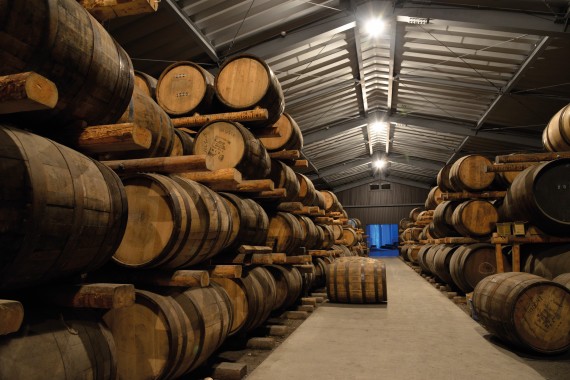In 1923 Suntory built the first commercial distillery in Japan, Yamazaki. For context, Scotch whisky production dates back to 1494 with its first commercial distilleries operating in the late 18th century. Not only is Japanese whisky much younger, it takes a lot of inspiration from Scotland. Martyn ‘Simo’ Simpson, owner of London’s Dram bar, points out: “The Japanese category was very much led by Scotland and what they were doing, but Japanese whisky has, in the last 10 or 20 years, exploded”.
Yumi Yoshikawa, Chichibu global brand ambassador, notes: “There are now around 120 companies in Japan producing whisky, a significant increase compared to just a few years ago. This growth reflects the rising interest in Japanese whisky both domestically and internationally.”
In the new wave of Japanese distilleries, Chichibu was at the forefront. Yoshikawa says: “After the Hakushu and Fuji Gotemba distilleries were licensed in 1973, there was a long period when nobody entered the whisky industry. Then in 2008, at a time when whisky consumption in Japan was at its lowest, Ichiro Akuto obtained a production licence for Chichibu.
“It wasn’t an easy time to start a distillery, but he pushed forward. His success not only helped open the door for others to get licensed but set a standard by producing high-quality whisky that gained international recognition. In many ways, his determination and achievements laid the foundation for today’s new wave of Japanese distillers”.
As a result of Chichibu’s pioneering legacy, more and more brands are emerging in Japanese whisky and further shaking up the category. Simpson highlights Kanosuke as one such brand, saying of its producers: “For me, they represent the future of Japanese whisky. They are from a family of ex-shochu makers and they make their whisky in the style of shochu, and the biggest thing they do is their fermentation. They use steel tanks that are water jacketed so they can regulate the temperature around the outside and regulate fermentation, so they can actually slow it down to about 144 hours of fermentation, which gives a super-fruity liquid. People are really pushing distillation types and fermentation.”
In terms of experimentation, Yoshikawa adds: “Although our own production capacity is limited due to the size of our facilities, we believe it’s essential to showcase what we can do, especially to whisky experts and our long-standing partners. In that sense, releases such as the London Edition and Paris Edition are great examples. These small-batch single malts highlight the subtle differences in flavour from year to year and allow people to get to know the distillery more intimately. By adjusting the production slightly with each release, we can demonstrate both the character of our whisky and the potential for ongoing exploration within the category.”
The distillery has also recently partnered with Simpson’s Dram to introduce an ultra-limited release drawn from one of Chichibu’s smallest and most distinctive casks, exclusively available through the bar, with an allocation of only 100 bottles. Simpson says: “This project represents the best of collaboration in the drinks industry: shared values, shared creativity and a shared appreciation for truly great whisky.”
Long-term strategy
Other distilleries are also riding this new wave, including Komoro Distillery, a subsidiary of Karuizawa Distillers which is currently developing a new distillery project in Furano city, Hokkaido. Koji Shimaoka, chief executive of Karuizawa Distillers, says the decision behind the project is part of a long-term growth strategy. “We believe demand for authentic Japanese whisky will continue to rise and, right now, supply remains limited. By building a new distillery, we aim to help meet that demand with high-quality, transparent and original whisky.
“There’s definitely a surge in interest, both domestically and internationally. With that interest comes responsibility and starting a new distillery today is a serious long-term commitment,” Shimaoka adds.
“We hope to see more thoughtful entrants in the market – ones who raise the bar for quality and innovation. A more diverse range of distilleries and expressions will benefit both the industry and consumers. For us, the focus is always on quality, storytelling and customer experience.”
Ray Lombard, vice-president of supplier development and marketing at Southern Glazer’s, the largest wine and spirits distributor in the US, adds: “The new wave is exciting, especially as consumers become more curious and look for variety. While not every new release is at the level of Japan’s legacy producer-owned distilleries like Yamazaki or Nikka, the innovation is intriguing and will bring consumers to the Japanese whisky category.”
Yoshikawa says that for Japanese whisky to evolve into a “truly strong and globally respected category, it’s important that we attract more producers who are committed to craftsmanship, authenticity, and innovation”. She adds: “It’s not just about increasing numbers, it’s about raising the overall standard and continuing to innovate while honouring the traditions that make Japanese whisky unique.”
According to Simpson, Japanese whisky will likely follow the path that Scotch took with its rise in non-age statements about a decade ago, and which Japan will continue to see over the next 10-15 years.
“We’re starting to see it now, a lot of new brands won’t have age statements on there, and they’re going to really focus on the new make and what that tastes like young. Rather than waiting for that age product, they’re going to bring out younger whisky within the five to 10-year mark and concentrate on the new make, that’s going to be the important thing,” says Simpson.
“Scotch is a craft, being made for hundreds of years, but Japanese whisky is like the true art of the craft. Japanese whisky is leading the way on refinement. If what they do in Scotland is with a baseball bat, what they do in Japan is with a scalpel. Scotch has so much stock they can just play around with it, but in Japan they are making tiny, minute changes and it’s very refined.”


AloJapan.com